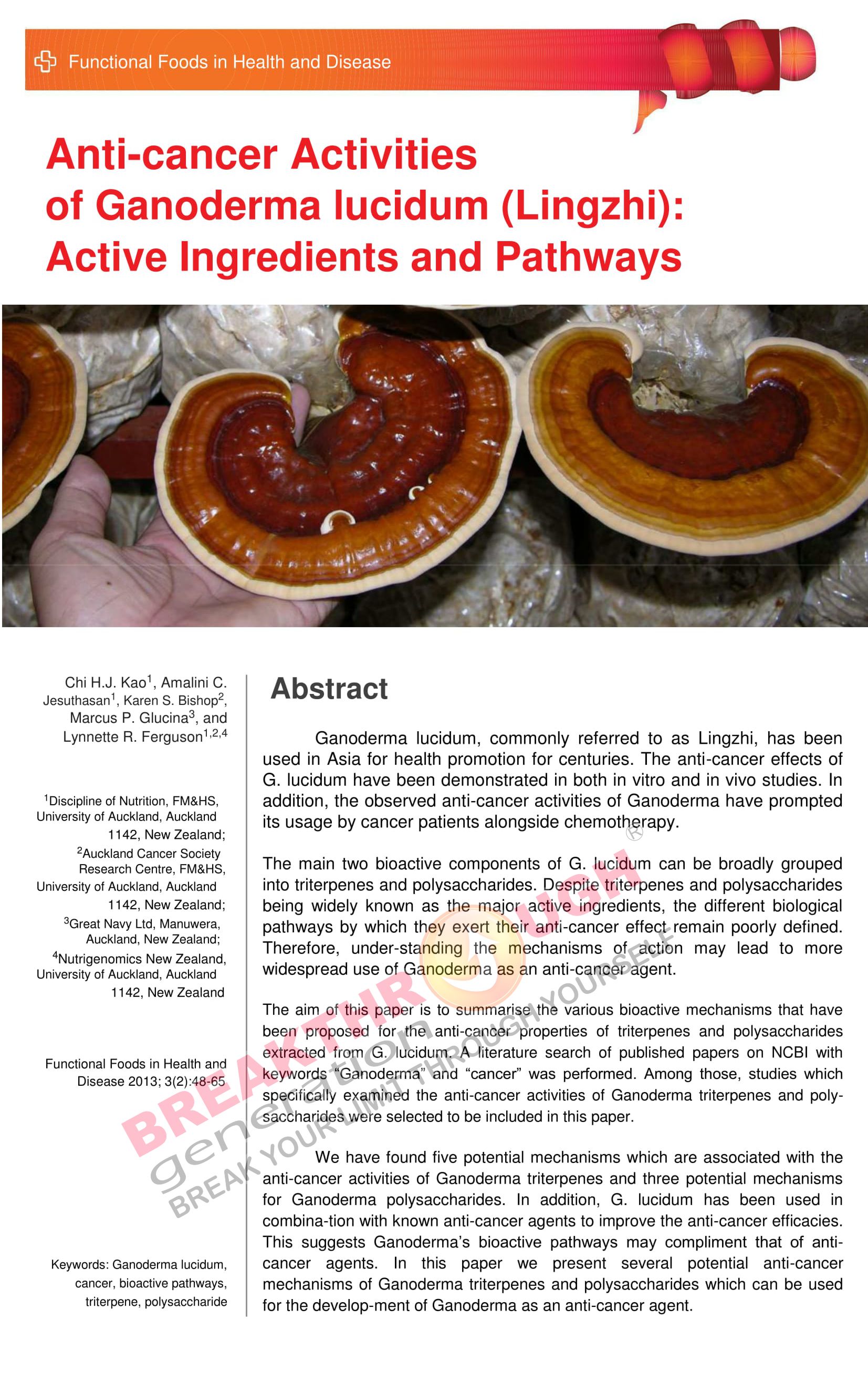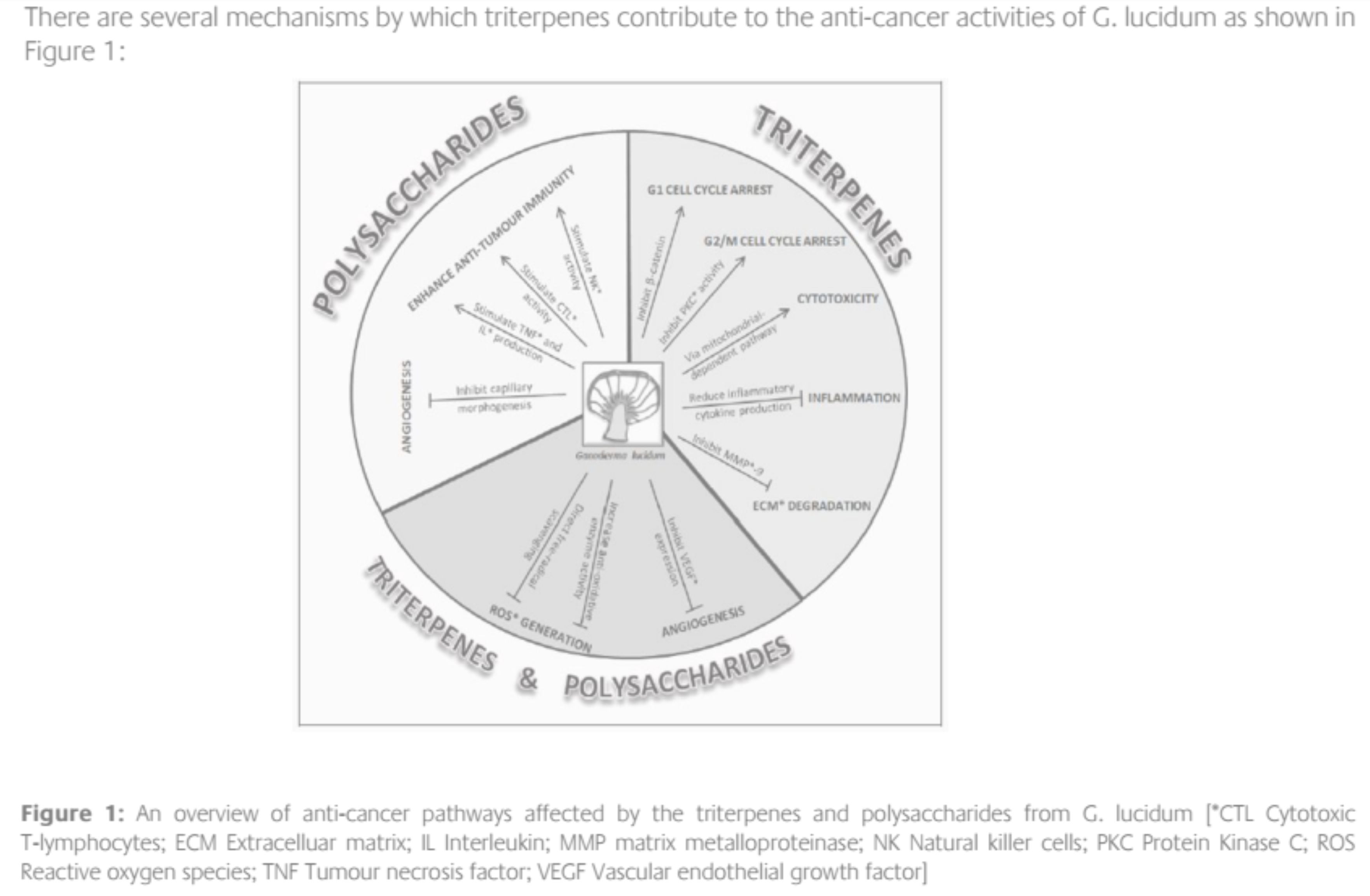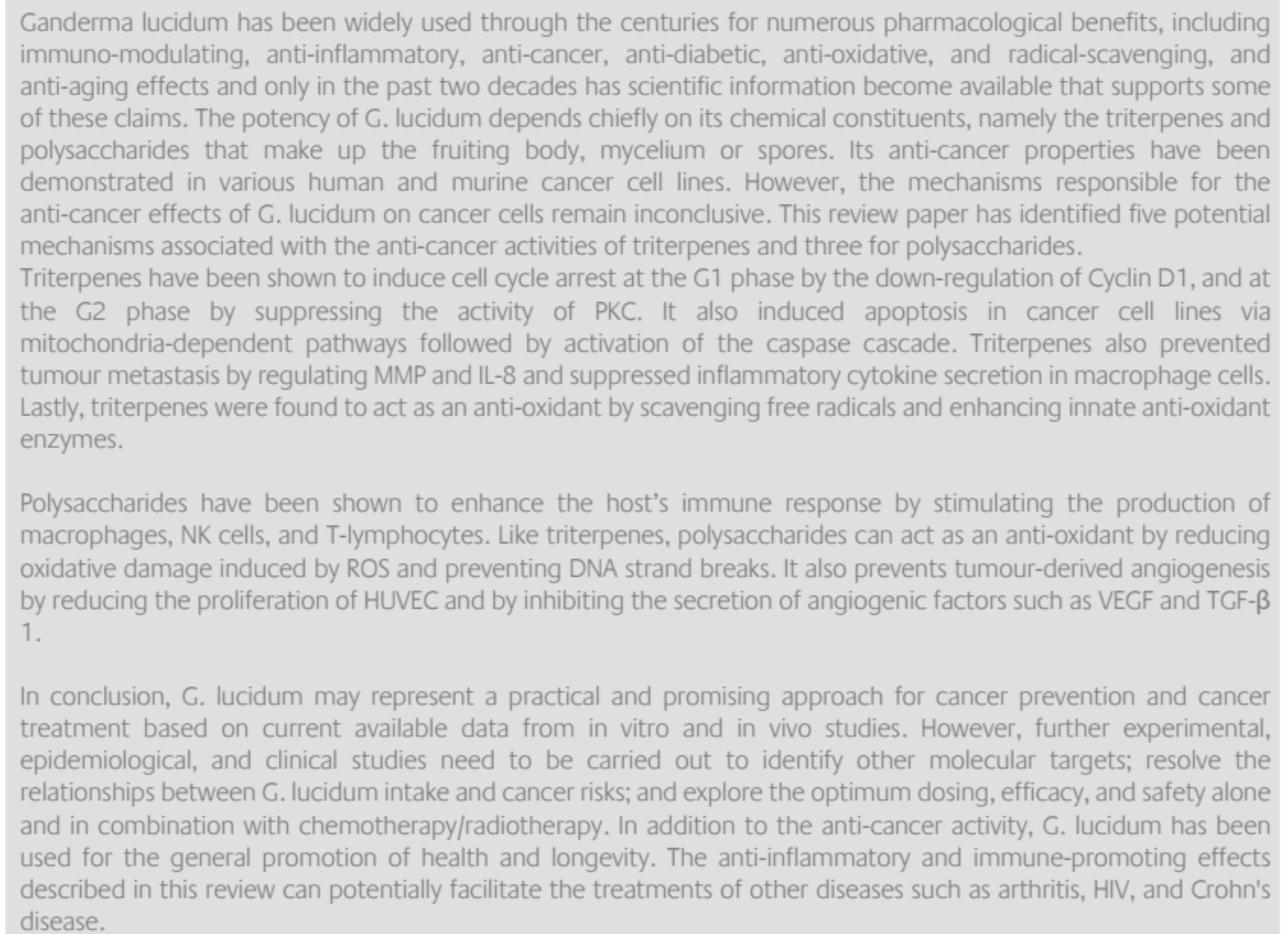Anti-cancer Activities of Ganoderma lucidum (Lingzhi) : Active Ingredients and Pathways
 INTRODUCTION
INTRODUCTION
Ganoderma lucidum (G. lucidum), commonly referred to as Lingzhi in China, is a fungus which has been widely used through the centuries for the general promotion of health and longevity in Asian countries. It has been known to have numerous pharmacological effects including immuno-modulating, anti-inflammatory, anti-cancer, anti-diabetic, anti-oxidative and radical-scavenging, and anti-aging effects.
Most mushrooms are 90% water by weight. For G. lucidum, the remaining 10% consists of 26–28% carbohydrate, 3–5% crude fat, 59% crude fibre, and 7–8% crude protein. In addition, G. lucidum contains a wide variety of bioac-tive constituents such as terpenoids, steroids, phenols, glycoproteins, and polysaccharides [3, 4]. Numerous authors have shown that triterpenes and polysaccharides are the major physiologically active components of G. lucidum.
In this review, we focused on the various bioactive pathways thought to be associated with the anti-cancer activities of G. lucidum, in particular, the two main active ingredients: triterpenes and polysaccharides.
Triterpenes
Triterpenes are one of the possible pharmaceutically active compounds contributing to the medicinal activities of G. lucidum. Triterpenes are a subtype of Terpene, a class of naturally occurring compounds, composed of one or more isoprene units. Terpenes are widely distributed throughout the plant world. Many subtypes of Terpenes have been found to have anti-inflammatory, anti-tumourigenic, and hypolipidemic activity. Triterpenes contain six isoprene units. The isoprenes may form linear chains or fold-up and form a ring-like structure. Ganoderic acid is a sub-type of triterpenes with four cyclic and two linear isoprenes. There are over 140 species of triterpenes and triterpenoids iden-tified in G. lucidum.
Triterpenes are primarily isolated from the spores of G. lucidum and have shown remarkable pharmacological and therapeutic activities on multiple human diseases including cancer. Extraction of triterpenes is usually by means of methanol, ethanol, acetone, chloroform, ether, or a mixture of these solvents.
Studies have shown that many subtypes of triterpene extracts from G. lucidum can directly induce apoptosis of multiple human cancer cell lines. The cytotoxic effect varied greatly between different subtypes of triterpenes. Some subspecies of triterpenes have shown strong cytotoxic effects at low concentrations in various human cancer cell lines, these include:
Ganoderic acid T is the most abundant triterpenic acid found in G. lucidum and shows significant anti-cancer effects in both in vitro and in vivo studies. In a study by Chen et al. (2010), Ganoderic acid T was shown to inhibit tumour invasion by inhibiting Matrix Metalloproteinase (MMP)-9 expression. Ganoderic acid D has been shown to directly bind to 14-3-3ζ protein in a study by Yue et al. (2008), and this binding may contribute to the apoptosis observed in HeLa cell. Ganoderiol F (GA-F) is a tetracyclic triterpene found in Ganoderma species. GA-F has shown cytotoxicity in vitro against Lewis lung carcinoma (LLC), Meth-A, Sarcoma-180, and T-47D cell lines. In addition, the anti-tumour effect of GA-F has been demonstrated in vivo in rats implanted with LLC tumour cells. Additional forms of triterpenes isolated from G. lucidum have shown cytotoxicity in the following human cancer cell lines: p388, HeLa, BEL-7402, and SGC-7901.

Polysaccharides are long chain sugar molecules joined together by glycosidic bonds. Various types of polysaccharides, with molecular weights ranging from 4 × 105 to 1 × 106 Da have been identified in G. lucidum; mostly in the fruiting body and mycelia, and a few have been found in the spores.
Structural analysis shows that polysaccharides of G. lucidum are all heteropolymers. Glucose forms the major share of the sugar molecules; with xylose, mannose, galactose, and fucose in different conformations. It is hypothesised that the polysaccharides extracted from different parts of G. lucidum induce different immune responses with varying immune potencies. The different branching conformation and solubility characteristics affects the anti-tumourigenic properties of these polysaccharides. β-D-glucans consisting of (1-3)-, (1-4)- and (1-6)-β-D linkages are known to have a stronger anti-tumour potency and better absorption than other polysaccharides in G. lucidum.
Together with the high concentration of high molecular-weight polysaccharides, the mushroom also consists of a matrix of the polysaccharide chitin, which is largely indigestible and is partly responsible for the physical hardness of the mushroom. There are three mechanisms by which Ganoderma polysaccharides exert their anti-cancer effect as shown in Figure 1.
Polysaccharides are long chain sugar molecules joined together by glycosidic bonds. Various types of polysaccharides, with molecular weights ranging from 4 × 105 to 1 × 106 Da have been identified in G. lucidum; mostly in the fruiting body and mycelia, and a few have been found in the spores.
Structural analysis shows that polysaccharides of G. lucidum are all heteropolymers. Glucose forms the major share of the sugar molecules; with xylose, mannose, galactose, and fucose in different conformations. It is hypothesised that the polysaccharides extracted from different parts of G. lucidum induce different immune responses with varying immune potencies. The different branching conformation and solubility characteristics affects the anti-tumourigenic properties of these polysaccharides. β-D-glucans consisting of (1-3)-, (1-4)- and (1-6)-β-D linkages are known to have a stronger anti-tumour potency and better absorption than other polysaccharides in G. lucidum.
Together with the high concentration of high molecular-weight polysaccharides, the mushroom also consists of a matrix of the polysaccharide chitin, which is largely indigestible and is partly responsible for the physical hardness of the mushroom. There are three mechanisms by which Ganoderma polysaccharides exert their anti-cancer effect as shown in Figure 1.
Improve Immune Response
In contrast to triterpenes, numerous studies have shown that polysaccharides exert their anti-cancer effect by enhancing the host’s immune system rather than via a direct cytotoxic effect. This involves the stimulation of macro-phages, natural killer (NK) cells, and cytotoxic T-lymphocytes (CTL) activities along with their secretory products like TNF, reactive nitrogen and oxygen intermediates, and interleukins. In a study performed by Wang et al. (1997), it was shown that polysaccharides extracted from the fresh fruiting bodies of G. lucidum can stimulate the production of IL-1β, IL-6, TNF-α, and interferon-γ (IFN-γ) in human monocyte-macrophages and T-lymphocytes.
It is widely known that macrophages play an important role in many primary defence mechanisms via phagocytosis and secretion of immune cytokines in response to micro-environmental signals. The G. lucidum immune-modulating substance, (a proteoglycan isolated from the fruiting body of G. lucidum), activate bone marrow-derived macro-phages in a dose-dependent manner. These activated macrophages showed a marked increase in their phagocytosis activity and increased production of IL-1β and nitric oxide.
The Major Histocompatibility Complex (MHC) is a type of protein expressed on all cell surfaces. The main function of MHC is to display a molecular fraction of proteins that are formed within the cell, a process known as antigen presen-tation. Cancer cells, which have abnormal proteins or changes in amount of protein expression, can be detected by immune cells via antigen presentation which leads to CTL mediated apoptosis. Cancer cells may reduce the expres-sion of MHC molecules to escape CTL mediated apoptosis. NK cells can detect and induce apoptosis of cancerous cells with low MHC expression.
Fraction-3 (F3), a fucose-containing glycoprotein extracted from G. lucidum, stimulated the proliferation of murine spleen cells and expression of various cytokines, including IL-1, IL-2, and IFN-γ [76]. A study by Chien et al. (2004) showed that F3 treatment of mononuclear cells extracted from human umbilical cord blood stimulated their differ-entiation into macrophages and NK cells by 2.9 and 1.5 times respectively. Another study showed that an F3-treated human acute monocytic leukemia (THP-1) cell line exhibited enhanced macrophage differentiation via caspases and p53 activation. This differentiation was demonstrated by changes in cell adherence, cell cycle arrest, increase in the expression of differentiation markers, and down-regulation of myeloperoxidase (MPO). The enzyme MPO is synthe-sized only in myeloid and monocytic cells and the down-regulation of MPO activity is a characteristic feature in mac-rophage differentiation.
These results showed that polysaccharides obtained from G. lucidum could effectively increase the cellular immune activity in-vitro as well as in-vivo, by modulating cytokine production.
Suppression of Angiogenesis
Angiogenesis is a physiological process involving the development of new blood vessels from pre-existing vessels. The normal regulation of angiogenesis is governed by a fine balance between factors that induce the development of blood vessels and those that inhibit this process. A disruption of this balance leads to pathological angiogenesis. Tumour cells are known to induce angiogenesis by secreting various growth factors such as VEGF which induce capil-lary growth into the tumour, supplying it with required nutrients and allowing for tumour expansion and metastasis. Studies have shown that G. lucidum possesses anti-angiogenic activity and can also inhibit the production of nitric oxide, an inducing agent of angiogenesis overexpressed in tumours [83]. A study by Cao et al. (2006) showed that a polysaccharide peptide (Gl-PP) isolated from G. lucidum inhibits the proliferation of human umbilical cord vascular endothelial cells (HUVEC) in a dose-dependent manner. In human lung carcinoma cells, a high dose of Gl-PP for 18 hours under hypoxic conditions led to a decrease in the amount of secreted VEGF. In HUVECs, Gl-PP led to a reduction in Bcl-2 expression and an increase in Bax expression which induces apoptosis in vascular endothelial cells. Therefore, Gl-PP may inhibit angiogenesis via inhibiting secretion of pro-angiogenic factors and inhibition of vascular endothelial cell proliferation. It is possible that the cytotoxicity effect and the inhibition of proliferation observed in both polysac-charide and triterpene extracts may have the same bioactive pathways.
A study by Stanley et al. (2005) found that G. lucidum prevents capillary morphogenesis, an important step in angio-genesis associated with the growth and progression of cancer. G. lucidum significantly inhibited capillary morpho-genesis by inhibiting the secretion of angiogenic factors VEGF and Transforming Growth Factor (TGF)-β1. G. lucidum was shown to inhibit prostate cancer angiogenesis by modulating MAPK and Protein Kinase B signalling and altering the phosphorylation of extracellular signal-regulated kinases 1/2 and Akt kinases.
Extraction Methods
The whole spores, fruiting bodies and cultivated mycelia of G. lucidum as well as its triterpenes and polysaccharides extracts have been widely tested for their various anti-tumour properties. Different sources of G. lucidum and varying extraction procedures to obtain the required components have been used in various studies. The extraction process is a necessary step to purify the mushroom by eliminating unnecessary components that are produced by the mushroom’s natural growing process, while preserving the essential bioactive components within it. Numerous means of extraction have been developed with the objective of obtaining extracts with better yields and lower costs. Generally, most polysaccharides are extracted using water-extract-alcohol precipitation methods. The solubility and extraction efficiency in water depends on the molecular weight of the polysaccharide and water temperature, with lower molecular weight and hot water showing increased efficiency. However, this method has its disadvantages such as reduced yields, long extraction time and high extraction temperature, and hence new technologies are being developed to overcome these drawbacks. Novel technologies using ultrasound, microwave and enzymatic methods have recently been developed to increase the yield in shorter extraction times.
Extractions using ethanol have been reported to be the easiest approach to maintain the activity of the triterpene extracts and to scale up its production. Triterpenes are usually extracted using organic solvents such as methanol, ethanol, chloroform or ether followed by different separation methods. Ultrasonic techniques are currently being used to enhance the rate of extraction of triterpenes by destroying the dense structure in the cells.
Reduced metastatic potential
Cancer metastasis is a complex process by which cancer cells split from the primary tumour and invade other tissues and thereby form secondary tumours. Cancer metastasis, when left untreated, dramatically reduces the rate of cure and survival. There are several key proteins involved in cancer metastasis which may be regulated by G. lucidum triter-penes.
Matrix Metalloproteinase is a family of proteins that degrade the extracellular matrix and can promote cancer metastasis. Studies showed that Ganoderic acid extracted from G. lucidum suppressed invasion of 95-D, LLC, and HCT-116 metastatic cancer cells via inhibition of MMP-9 expression.
Interleukin (IL)-8 and other angiogenic factors such as vascular endothelial growth factor (VEGF) can induce angio-genesis and promote metastasis. Expression of IL-8 can be up-regulated by oxidative stress and overexpression of IL-8 is associated with the metastatic phenotype of breast cancer cells. Oxidative-induced IL-8 expression was reduced in a breast cancer cell line after treatment with G. Lucidum.
Ganoderma lucidum in combination with other cancer treatments
Radiation therapy is commonly used in the treatment of cancer in order to damage the DNA of tumour cells, to inhibit proliferation and induce apoptosis. The main side effect of using radiation therapy is DNA damage to the surrounding healthy tissues. Hence, protection of non-cancerous tissues against radiation is vital for reducing the side effects.
Many of the recent cytoprotective agents capable of protecting normal tissues against radiation-damage have some undesirable and serious side effects that limit their therapeutic applications. However, G. lucidum has been proven to exhibit radio-protective effects in normal cells and enhance the recovery of cellular immune-competence from gamma–irradiation.
Chen et al. (1995) studied the effect of G. lucidum in repairing the radiation-induced damage in a subset of T-lymphocytes in the spleen of gamma-irradiated mice. The mice were treated with whole body exposure to gamma-irradiation followed by administration of 400 mg/day/kg body weight of G. Lucidum. This was compared to the control, radiation-treated only mice, as well as radiation-treated mice administered with Krestin, a polysaccharide isolated from the basidomycetes of Coriolus versicolor. Results showed that after 28 days, irradiated mice treated with G. lucidum had the highest relative thymus weight with a greater number of CD4 and CD8 splenocytes and an increase in leukocyte counts. This showed that G. lucidum is effective (even more so than Coriolus versicolor extracts) in enhancing the recovery of cellular immunocompetence from gamma–irradiation.
Another study, performed by Pillai et al. (2006), showed that G. lucidum prevents DNA damage induced by radiation. Swiss albino mice, that were exposed to gamma rays and treated with G. lucidum fruiting-body extracts, were evaluated for radio-protective effects. Results showed that administration of G. lucidum extract resulted in 90% protection of plasmid DNA and prevented 98% of lipid peroxidation. From this study we can conclude that G. lucidum protects the DNA against radiation-induced single-strand breaks and thereby possesses significant radio-protective activity.
Cisplatin, the first clinical cancer chemotherapeutic agent belonging to the class of platinum-containing anti-cancer drugs, is widely used to treat a range of tumours. However, its benefits are counteracted by renal impairment with a decline in glomerular filtration, which is a common side effect of cisplatin. This nephrotoxicity has been thought to be due to the weakening of the renal anti-oxidant defence system. Since G. lucidum has been proven to possess in-vitro anti-oxidant properties, a study was conducted to examine the prevention of nephrotoxicity induced by the anti-cancer drug cisplatin. Swiss albino mice were treated with fruiting-body extracts of G. lucidum (250 and 500 mg/kg body weight) orally one hour before injecting cisplatin at a high dose (a level commonly used in clinical practice and found to produce nephrotoxicity and cytotoxicity). Nephrotoxicity was measured by determining the serum creatinine and urea levels and renal anti-oxidant status and results showed that it significantly reduced the elevated serum creatinine and urea levels. Renal anti-oxidant defence system (such as superoxide dismutase, catalase, glutathione peroxidase activities and reduced glutathione) levels following treatment with cisplatin were restored to normal and the therapeutic effects of cisplatin were retained.
These studies show that G. lucidum aids in the reduction of toxicities resulting from various popular modes of cancer treatment and could therefore play a major role in combination therapy for cancer treatments.
CONCLUSION


